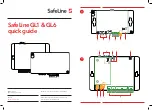
SIP User's Manual
398
Document #: LTRT-68808
Mediant
2000
9.3
ISDN Overlap Dialing
Overlap dialing is a dialing scheme used by several ISDN variants to send and / or receive
called number digits one after the other (or several at a time). This is in contrast to en-bloc
dialing in which a complete number is sent.
The device can optionally support ISDN overlap dialing for incoming ISDN calls for the
entire device by setting the
ini
file parameter ISDNRxOverlap to 1, or per E1/T1 span by
setting ISDNRxOverlap_x to 1 (where
x
represents the number of the trunk). For
configuring ISDN overlap dialing using the Web interface, refer to ''Configuring the Trunk
Settings'' on page
To play a Dial tone to the ISDN user side when an empty called number is received, set
ISDNINCallsBehavior = 65536 (bit #16). This results in the Progress Indicator to be
included in the SetupAck ISDN message.
The device stops collecting digits (for ISDN-to-IP calls) when:
The sending device transmits a ‘sending complete’ IE in the ISDN Setup or the
following INFO messages to signal that no more digits are going to be sent.
The inter-digit timeout (configured by the parameter TimeBetweenDigits) expires. The
default for this timeout is 4 seconds.
The maximum allowed number of digits (configured by the parameter MaxDigits) is
reached. The default is 30 digits.
A match is found with the defined digit map (configured by the parameter,
DigitMapping).
Relevant parameters (described in ''PSTN Parameters'' on page
ISDNRxOverlap
ISDNRxOverlap_x
TimeBetweenDigits
MaxDigits
ISDNInCallsBehavior
DigitMapping
9.4
ISDN Non-Facility Associated Signaling (NFAS)
In regular T1 ISDN trunks, a single 64 kbps channel carries signaling for the other 23 B-
channels of that particular T1 trunk. This channel is called the D-channel and usually
resides on timeslot # 24. The ISDN Non-Facility Associated Signaling (NFAS) feature
enables the use of a single D-channel to control multiple PRI interfaces.
With NFAS it is possible to define a group of T1 trunks, called an NFAS group, in which a
single D-channel carries ISDN signaling messages for the entire group. The NFAS group’s
B-channels are used to carry traffic such as voice or data. The NFAS mechanism also
enables definition of a backup D-channel on a different T1 trunk, to be used if the primary
D-channel fails.
The NFAS group can comprise up to 10 T1 trunks. Each T1 trunk is called an ‘NFAS
member’. The T1 trunk whose D-channel is used for signaling is called the ‘Primary NFAS
Trunk’. The T1 trunk whose D-channel is used for backup signaling is called the ‘Backup
NFAS Trunk’. The primary and backup trunks each carry 23 B-channels while all other
NFAS trunks each carry 24 B-channels.
The device supports up to 9 NFAS groups. Each group must contain different T1 trunks.
Содержание Mediant 2000
Страница 1: ...Document LTRT 68808 November 2008 User s Manual Version 5 6 ...
Страница 2: ......
Страница 18: ...SIP User s Manual 18 Document LTRT 68808 Mediant 2000 Reader s Notes ...
Страница 83: ...Version 5 6 83 November 2008 SIP User s Manual 3 Web Based Management Figure 3 47 Trunk Settings Page ...
Страница 254: ...SIP User s Manual 254 Document LTRT 68808 Mediant 2000 Reader s Notes ...
Страница 334: ...SIP User s Manual 334 Document LTRT 68808 Mediant 2000 Reader s Notes ...
Страница 342: ...SIP User s Manual 342 Document LTRT 68808 Mediant 2000 Reader s Notes ...
Страница 408: ...SIP User s Manual 408 Document LTRT 68808 Mediant 2000 Reader s Notes ...
Страница 414: ...SIP User s Manual 414 Document LTRT 68808 Mediant 2000 Reader s Notes ...
Страница 418: ...User s Manual Version 5 6 www audiocodes com ...
















































